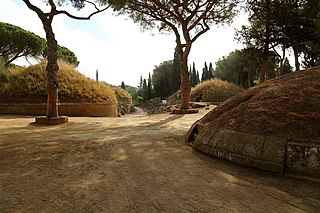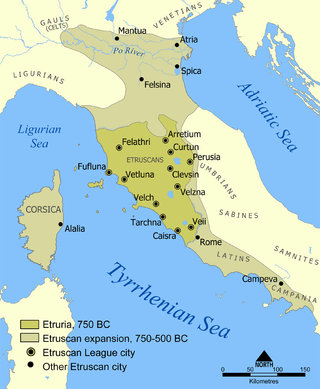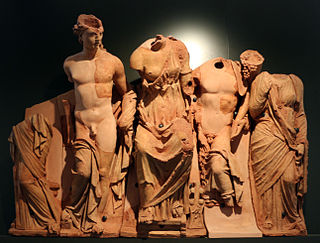
A cippus (pl. cippi) was a low, round, or rectangular pedestal set up by the Ancient Romans for purposes such as a milestone or a boundary post. They were also used for somewhat differing purposes by the Etruscans and Carthaginians.

A cippus (pl. cippi) was a low, round, or rectangular pedestal set up by the Ancient Romans for purposes such as a milestone or a boundary post. They were also used for somewhat differing purposes by the Etruscans and Carthaginians.
Roman cippi were made of wood or stone; inscriptions on the stone cippi indicate their function or the area that they surrounded, like sanctuaries and temple areas. In Rome they marked the limits of the pomerium after the city's walls were expanded further out, the course of aqueducts, and the cursus publicus . Cippi lined up in rows were also often numbered, often featuring the name of the person placing them or the distance to the nearest other cippus. The inscriptions on some cippi show that they were occasionally used as funeral memorials. [1]
Between 800–100 BC, cippi were used by the Etruscans as tombstones, which were shaped differently depending on the place and time of origin. Cippi were set up as a stele, column or sculpture in the dromos of an Etruscan grave or at the grave entrance. They had magical and religious significance. Cippi may have the shape of a cube, knob, onion, egg, ball or cylinder. There are connections between certain shapes and the representation of canopic jars; cinerary urns that were made in the shape of a human torso, and the head as a lid. [2] [3]
The "Cippus Abellanus" (in the Oscan language), like the "Cippus Perusinus", is not a tombstone. [4]
Carthaginian cippi have a base similar to Egyptian steles, which are sometimes also referred to as cippi (for example the "Metternich Cippi" in the Metropolitan Museum of Art). They are found in North Africa, but also in Sardinia (Cagliari, Teti, Tharros), Sicily (Motya) and Spain (Huelva and Barcelona). [1] The Cippi of Melqart, found in Malta, which bear a Phoenician and a Greek inscription, made it possible for the first time to understand the Phoenician alphabet. [5]

Etruscan was the language of the Etruscan civilization in the ancient region of Etruria, in Etruria Padana and Etruria Campana in what is now Italy. Etruscan influenced Latin but was eventually completely superseded by it. The Etruscans left around 13,000 inscriptions that have been found so far, only a small minority of which are of significant length; some bilingual inscriptions with texts also in Latin, Greek, or Phoenician; and a few dozen purported loanwords. Attested from 700 BC to AD 50, the relation of Etruscan to other languages has been a source of long-running speculation and study, with it mostly being referred to as one of the Tyrsenian languages, at times as an isolate and a number of other less well-known theories.

Melqart was the tutelary god of the Phoenician city-state of Tyre and a major deity in the Phoenician and Punic pantheons. He may have been central to the founding-myths of various Phoenician colonies throughout the Mediterranean, as well as the source of several myths concerning the exploits of Heracles. Many cities were thought to be founded and protected by Melqart, no doubt springing from the original Phoenician practice of building a Temple of Melqart at new colonies. Similar to Tammuz and Adonis, he symbolized an annual cycle of death and rebirth.

Astarte is the Hellenized form of the Ancient Near Eastern goddess ʿAṯtart. ʿAṯtart was the Northwest Semitic equivalent of the East Semitic goddess Ishtar.
The Canaanite languages, sometimes referred to as Canaanite dialects, are one of three subgroups of the Northwest Semitic languages, the others being Aramaic and Amorite. These closely related languages originate in the Levant and Mesopotamia, and were spoken by the ancient Semitic-speaking peoples of an area encompassing what is today Israel, Jordan, the Sinai Peninsula, Lebanon, Syria, Palestine, as well as some areas of southwestern Turkey (Anatolia), western and southern Iraq (Mesopotamia) and the northwestern corner of Saudi Arabia.
Clusium was an ancient city in Italy, one of several found at the site. The current municipality of Chiusi (Tuscany) partly overlaps this Roman walled city. The Roman city remodeled an earlier Etruscan city, Clevsin, found in the territory of a prehistoric culture, possibly also Etruscan or proto-Etruscan. The site is located in northern central Italy on the west side of the Apennines.

Cerveteri is a comune (municipality) in the Metropolitan City of Rome Capital, in the Italian region of Lazio. Known by the ancient Romans as Caere, and previously by the Etruscans as Caisra or Cisra, and as Agylla by the Greeks, its modern name derives from Caere Vetus used in the 13th century to distinguish it from Caere Novum.

The Lemnian language was spoken on the island of Lemnos, Greece, in the second half of the 6th century BC. It is mainly attested by an inscription found on a funerary stele, termed the Lemnos stele, discovered in 1885 near Kaminia. Fragments of inscriptions on local pottery show that it was spoken there by a community. In 2009, a newly discovered inscription was reported from the site of Hephaistia, the principal ancient city of Lemnos. Lemnian is largely accepted as being a Tyrsenian language, and as such related to Etruscan and Raetic. After the Athenians conquered the island in the latter half of the 6th century BC, Lemnian was replaced by Attic Greek.

Caere is the Latin name given by the Romans to one of the larger cities of southern Etruria, the modern Cerveteri, approximately 50–60 kilometres north-northwest of Rome. To the Etruscans it was known as Cisra, to the Greeks as Agylla and to the Phoenicians as 𐤊𐤉𐤔𐤓𐤉𐤀.

The Cippus Perusinus is a stone tablet (cippus) discovered on the hill of San Marco, in Perugia, Italy, in 1822. The tablet bears 46 lines of incised Etruscan text, about 130 words. The cippus, which seems to have been a border stone, appears to display a text dedicating a legal contract between the Etruscan families of Velthina and Afuna, regarding the sharing or use, including water rights, of a property upon which there was a tomb belonging to the noble Velthinas.

South Picene is an extinct Italic language belonging to the Sabellic subfamily. It is apparently unrelated to the North Picene language, which is not understood and therefore unclassified. South Picene texts were at first relatively inscrutable even though some words were clearly Indo-European. The discovery in 1983 that two of the apparently redundant punctuation marks were in reality simplified letters led to an incremental improvement in their understanding and a first translation in 1985. Difficulties remain. It may represent a third branch of Sabellic, along with Oscan and Umbrian, or the whole Sabellic linguistic area may be best regarded as a linguistic continuum. The paucity of evidence from most of the 'minor dialects' contributes to these difficulties.

The Punic religion, Carthaginian religion, or Western Phoenician religion in the western Mediterranean was a direct continuation of the Phoenician variety of the polytheistic ancient Canaanite religion. However, significant local differences developed over the centuries following the foundation of Carthage and other Punic communities elsewhere in North Africa, southern Spain, Sardinia, western Sicily, and Malta from the ninth century BC onward. After the conquest of these regions by the Roman Republic in the third and second centuries BC, Punic religious practices continued, surviving until the fourth century AD in some cases. As with most cultures of the ancient Mediterranean, Punic religion suffused their society and there was no stark distinction between religious and secular spheres. Sources on Punic religion are poor. There are no surviving literary sources and Punic religion is primarily reconstructed from inscriptions and archaeological evidence. An important sacred space in Punic religion appears to have been the large open air sanctuaries known as tophets in modern scholarship, in which urns containing the cremated bones of infants and animals were buried. There is a long-running scholarly debate about whether child sacrifice occurred at these locations, as suggested by Greco-Roman and biblical sources.

The Sarcophagus of the Spouses is a tomb effigy considered one of the masterpieces of Etruscan art. The Etruscans lived in Italy between two main rivers, the Arno and the Tiber, and were in contact with the Ancient Greeks through trade, mainly during the Orientalizing and Archaic Period. The Etruscans were well known for their terracotta sculptures and funerary art, largely sarcophagi and urns. The sarcophagus is a late sixth-century BCE Etruscan anthropoid sarcophagus that was found at the Banditaccia necropolis in Caere and is now located in the National Etruscan Museum of Villa Giulia, Rome.

Etruscan art was produced by the Etruscan civilization in central Italy between the 10th and 1st centuries BC. From around 750 BC it was heavily influenced by Greek art, which was imported by the Etruscans, but always retained distinct characteristics. Particularly strong in this tradition were figurative sculpture in terracotta, wall-painting and metalworking especially in bronze. Jewellery and engraved gems of high quality were produced.

Ancient Carthage was an ancient Semitic civilisation based in North Africa. Initially a settlement in present-day Tunisia, it later became a city-state and then an empire. Founded by the Phoenicians in the ninth century BC, Carthage reached its height in the fourth century BC as one of the largest metropolises in the world. It was the centre of the Carthaginian Empire, a major power led by the Punic people who dominated the ancient western and central Mediterranean Sea. Following the Punic Wars, Carthage was destroyed by the Romans in 146 BC, who later rebuilt the city lavishly.

The Cippi of Melqart are a pair of Phoenician marble cippi that were unearthed in Malta under undocumented circumstances and dated to the 2nd century BC. These are votive offerings to the god Melqart, and are inscribed in two languages, Ancient Greek and Phoenician, and in the two corresponding scripts, the Greek and the Phoenician alphabet. They were discovered in the late 17th century, and the identification of their inscription in a letter dated 1694 made them the first Phoenician writing to be identified and published in modern times. Because they present essentially the same text, the cippi provided the key to the modern understanding of the Phoenician language. In 1758, the French scholar Jean-Jacques Barthélémy relied on their inscription, which used 17 of the 22 letters of the Phoenician alphabet, to decipher the unknown language.
Kanaanäische und Aramäische Inschriften, or KAI, is the standard source for the original text of Canaanite and Aramaic inscriptions not contained in the Hebrew Bible.

The Gozo stele is a Phoenician language inscription found near Gozo, Malta in 1855. It is currently in the Gozo Museum of Archaeology.
The Cippus Abellanus is a stone slab inscribed in the Oscan language. It is one of the most important examples of the Oscan language along with the Tabula Bantina.

Etruscan sculpture was one of the most important artistic expressions of the Etruscan people, who inhabited the regions of Northern Italy and Central Italy between about the 9th century BC and the 1st century BC. Etruscan art was largely a derivation of Greek art, although developed with many characteristics of its own. Given the almost total lack of Etruscan written documents, a problem compounded by the paucity of information on their language—still largely undeciphered—it is in their art that the keys to the reconstruction of their history are to be found, although Greek and Roman chronicles are also of great help. Like its culture in general, Etruscan sculpture has many obscure aspects for scholars, being the subject of controversy and forcing them to propose their interpretations always tentatively, but the consensus is that it was part of the most important and original legacy of Italian art and even contributed significantly to the initial formation of the artistic traditions of ancient Rome. The view of Etruscan sculpture as a homogeneous whole is erroneous, there being important variations, both regional and temporal.
The Tharros Punic inscriptions are a group of Punic inscriptions found at the archeological site of Tharros in Sardinia.
Band III,2
{{cite book}}: |work= ignored (help)CS1 maint: location missing publisher (link){{cite book}}: |work= ignored (help){{cite book}}: |work= ignored (help)